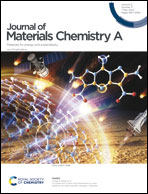A low-cost and large-area modular nickel electrode on aramid fabric for efficient solar-driven water electrolysis†
Abstract
We demonstrate a water splitting electrode on aramid fabric. SnS2 is firstly synthesized on the fabric on the scale from 1 cm2 to 18 cm2, and nickel is subsequently electrodeposited uniformly on the SnS2. The electrode surface is composed of nanostructured nickel oxides, which are highly efficient water splitting electrocatalysts. The Ni/SnS2/aramid electrode can be used as a cathode for hydrogen evolution and an anode for oxygen evolution with 100% Faraday efficiency. Numerical simulation suggests intrinsic limiting factors associated with electrode upscaling in a parallel-electrode configuration. The simulation and comparison with our experimental data suggest that OH− depletion at the surface and the porosity of the electrodes introduce a significant voltage loss with increasing electrode area in a parallel-electrode configuration, which cannot be solved by nanostructuring. The efficient water splitting is attributed to the highly nanostructured surface, providing a significantly large quantity of surface area. The 10 cm2 Ni/SnS2/aramid electrodes exhibit 13.5% solar-to-hydrogen efficiency and 120 hours stability combined with a silicon solar cell. Our strategy using fabric materials as the electrolysis substrates not only suggests the use of inexpensive fabric materials for hydrogen production but also demonstrates the potential of a new design using flexible electrodes at low cost to achieve high efficiency of water splitting.

- This article is part of the themed collection: Journal of Materials Chemistry A HOT Papers


 Please wait while we load your content...
Please wait while we load your content...